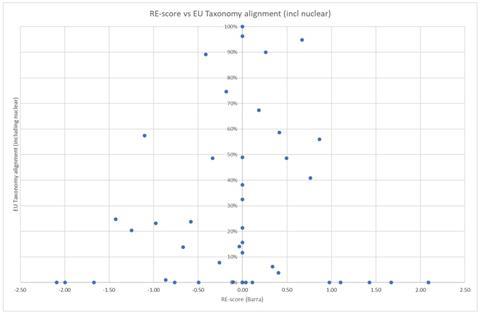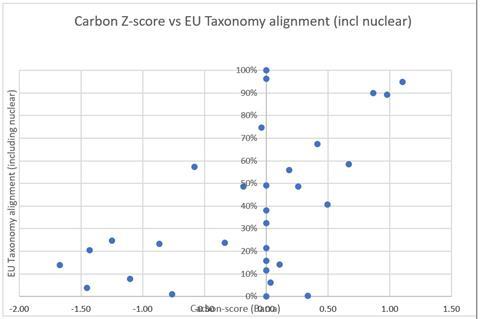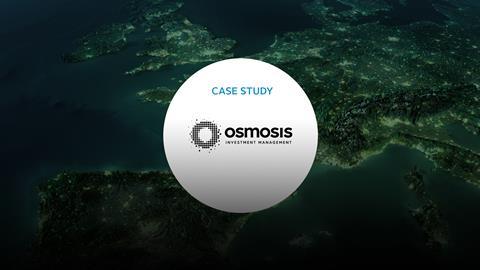| ORGANISATION DETAILS | |
|---|---|
| Name | Osmosis Investment Management |
| Signatory type | Investment manager |
| Region of operation | UK |
| Assets under management | N/A |
| COVERED IN THIS CASE STUDY | |
|---|---|
| Name of fund | N/A |
| Sector | Electric utilities |
| Asset class | Equity |
| Geography | Global |
| Environmental objective | Mitigation |
| Economic activity | Production of electricity (from solar PV, concentrated solar power, wind power, ocean energy, hydropower, geothermal, gas, bioenergy) |
Osmosis believes the taxonomy is a useful tool for investors to improve their analysis of corporate sustainability initiatives. It can provide markets with a consistent framework and methodology, and incentivize companies to measure and improve environmental performance.
The taxonomy is also highly aligned with our investment philosophy. Our ability to identify market inefficiencies and improve performance of mispriced equities should be enhanced as more companies incorporate sustainability into their business models and disclose activities in more detail. Osmosis will remain diligent in improving and refining our models, capitalizing on the insights we have accrued as a result of our leading position in sustainable investment.
Our analysis of corporate sustainability data has identified uncorrelated sources of alpha in publicly-listed companies. This systematic and quantitative approach has resulted in investment portfolios with a much lower environmental footprint relative to market benchmarks, delivering superior risk-adjusted returns over the long-term, and significantly reducing use of natural resources.
Our Model of Resource Efficiency (MoRE) has leveraged relevant carbon, water and waste data from corporate reports and employed it to build an environmental balance sheet of companies. We have linked environmental and financial balance sheets to indicate Resource Efficiency (RE). From this basis we have been equipped to build our product range.
This case study focuses on applying the strict rules-based taxonomy to our investment model. As our model uses objective, measurable data to select the best environmental performers within each sector, we assumed our approach would be naturally aligned with the criteria and thresholds set out in the EU Taxonomy. However, as our focus is broader than just carbon, encompassing water and waste impacts, we identified a potential disconnect between our products and taxonomy alignment. By linking environmental and financial balance sheets, we were able to select companies that were better at creating value while consuming fewer resources. However, this approach may not directly align with the detailed, activity level criteria set out in the taxonomy, such as 1.514tCO2e/t of aluminium, 0.766 tCO2e/t of clinker, 1.328 tCO2e/t of hot metal, etc.
We aimed to assess companies within a specific sector against the taxonomy criteria, flagging data availability and reliability issues, and explaining why it was difficult, at this point, to apply this analysis to all sectors. We then assessed to what extent our RE signal, which includes the impact of adding water and waste, is aligned with taxonomy criteria, and whether our initial assumption that our approach was naturally aligned with the taxonomy could be substantiated.
We focused solely on climate change mitigation, and did not assess Do No Significant Harm (DNSH) or minimum social safeguards.
Taxonomy implementation
Principles, criteria, thresholds
We applied the strict rule-based taxonomy to our investment model, taking the principles, criteria and thresholds from the latest Technical Annex, pages 205 to 286 (electricity, gas, steam and air conditioning). We focused on all activities relating to Production of Electricity (4.1 to 4.9), where it was clear that alignment was largely based on both the energy source and life-cycle emissions (gCO2e/kWh generated).
We mainly relied on CDP data to analyse electricity-producing companies. Electric utilities companies were asked to provide net and gross generation figures per major source (including hard coal, lignite, oil, gas, nuclear, wind, solar, biothermal, waste, etc.), as well as associated Scope 1 emissions. If sufficient data was provided, the carbon intensity could be calculated in gCO2e/kWh for each power source. We assumed that this figure would approximate life-cycle emissions. However, this could also be addressed by lowering the threshold from 100gCO2e/kWh. All renewable sources and gas were classified as taxonomy-aligned as long as they operated under the 100gCO2e/kWh threshold. Coal, lignite and oil were excluded.
We broke down each company’s generation sources to calculate gCO2e/kWh and hence determine alignment. Then we combined this calculation with revenue figures per source to reach a percentage for overall company alignment.
Do no significant harm assessment
Not considered due to lack of data.
Social safeguards assessment
Not considered due to lack of data.
Turnover/capex/opex alignment
We estimated revenue figures per power generated by using the percentage of power generated from each source versus the overall generation per company. Until better data becomes available we believe this can be an adequate proxy for a sector as homogenous as the power sector. For example, if a company generated equal amounts of kWh from coal and hydro, each would obtain a 50% weighting in the company’s final alignment score.
Alignment results
We focused on all 50 electricity producing companies within the MSCI World Index: for 31 of them we calculated an alignment percentage using CDP data. This ranged from 0% (a company producing electricity from coal, oil and nuclear) to 100% (a company only producing hydro and wind energy), with an average alignment of 23%. For the remaining 19 companies no CDP data was found.
Figure 1 shows the results of our initial analysis of companies in the Electric Utilities sector of the MSCI World Index. Combining different data sources, including the MoRE database and CDP energy production and carbon intensity figures, we calculated the proportion of energy generated per company that is aligned with the taxonomy criteria. Companies with no RE data, or insufficient data to calculate alignment with the taxonomy, were placed on the vertical or horizontal axes respectively. While data availability was a challenge, we could clearly see that companies with a positive RE score were more aligned with the EU Taxonomy criteria than resource inefficient companies.
Our RE signal was based on carbon, water and waste inputs, a combination that ensures a reliable assessment. However, for the scope of this analysis, we also extracted an Osmosis’ carbon score for companies, and plotted it against the company taxonomy alignment score. As expected, there was an even stronger relation between our carbon score and the taxonomy than between the RE score and the taxonomy. However, Figure 1 clearly shows that, even after incorporating water and waste into our signal, our research outcomes were naturally aligned with the taxonomy for this sector.
We then applied this methodology to our portfolios, rather than to the entire MSCI World benchmark. However, we failed to obtain meaningful results because of the number of holdings within the portfolio. We require more data to assess other sectors.
Figure 1. Resource Efficiency (RE) versus EU Taxonomy alignment of companies in the Electric Utilities sector. Source: Osmosis IM, Bloomberg, CDP.

Figure 2. Osmosis’ Carbon Score versus EU Taxonomy alignment of companies in the Electric Utilities sector. Source: Osmosis IM, Bloomberg, CDP.

Challenges and solutions
| NO. | CHALLENGE | SOLUTION |
|---|---|---|
| 1 | Data availability, environmental data | Solution implemented: After assessing all activities detailed in the Technical Annex, only the power production sector had sufficient data. We used CDP data to calculate the carbon intensity of different power production methods. |
| 2 | Data availability | Solution implemented: We could not identify consistent revenue breakdown that corresponded to the environmental data breakdowns. We therefore made the assumption that the share of revenue per power production method was similar to the share of power generated by that source. |
Recommendations
It is critical that all market participants strictly follow the principles, criteria and thresholds of the taxonomy. We caution against market participant interpreting the guidelines in a liberal way, as this will dilute the use of the taxonomy. We believe the EU Taxonomy can be game-changer by providing a clear and comprehensive list of activities, criteria and thresholds to determine sustainability. Our view is that you cannot fill forward areas such as electric aviation, low-carbon feedstock and sustainable agriculture, and overlook other key aspects of the taxonomy, all the while branding the product as a method to determine taxonomy alignment. While we acknowledge that the Technical Expert Group (TEG) report is clearly not complete, we hold the view that you can only determine the alignment of an activity based on the whole report.












